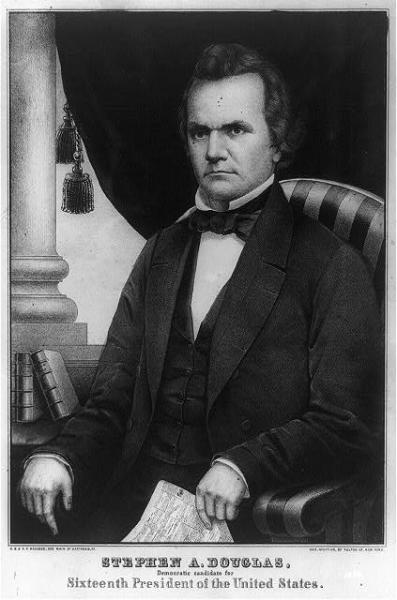By Zach Garrison, University of Cincinnati
Popular sovereignty in 19th century America emerged as a compromise strategy for determining whether a Western territory would permit or prohibit slavery. First promoted in the 1840s in response to debates over western expansion, popular sovereignty argued that in a democracy, residents of a territory, and not the federal government, should be allowed to decide on slavery within their borders. In 1854, Stephen Douglas most famously attempted to implement the measure with the Kansas-Nebraska Act. A major consequence of popular sovereignty’s application was the rush by both pro- and anti-slavery forces to populate Kansas and determine its fate, which manifested in violence and fraud.
In 1846, the Wilmot Proviso, which sought to forbid slavery in the territories acquired following the Mexican-American War, died on the floor of the Senate. In an effort to prevent future prohibitive measures against slavery in the West, Democratic Senator Lewis Cass of Michigan, offered up the idea of popular sovereignty. In theory, as Cass and his supporters reasoned, in a democratic society free citizens determined the future.
But in practice, questions remained concerning how to determine who qualified as a resident of a territory, how to regulate voting fraud, and what would happen to slaveowners and their slaves in territories where slavery was voted down. Still, by allowing the people to decide, Cass hoped to ease the building tensions between the Northern and Southern wings of the Democratic Party. Nonetheless, sectional debate and instability continued unabated.
In order to avoid further threats of disunion, Senator Henry Clay devised the Compromise of 1850 as a final panacea. A key component of the compromise was the implementation of popular sovereignty in the newly created Utah and New Mexico Territories. In this case, citizens in each territory were expected to vote on the slavery issue in the near future, and a climate unfavorable to plantation slavery made their votes non-controversial. Although popular sovereignty—alongside the banning of the slave trade in Washington, D.C., and the strengthening of the Fugitive Slave Law—ameliorated immediate sectional violence, the expected statehood of the territories immediately west of Missouri loomed large.
The border between Kansas and Missouri became a hotbed of violence and intimidation.
In 1854, Democratic Senator Stephen A. Douglas, of Illinois, hoped to once again employ the principles of popular sovereignty in order to address the slavery debate, this time in the Kansas and Nebraska territories. To Douglas’s dismay, dissatisfaction came from all sides. Northern critics of the proposal decried the apparent dismissal of the Missouri Compromise of 1820 that had banned slavery above the 36° 30' latitude line, while southerners believed that slaveholders were in the minority and therefore stood no chance of extending slavery to the West.
Responding to the basic tenets of popular sovereignty, groups and organizations in both the North and the South encouraged and aided families and individuals to migrate to Kansas and sway the final vote. The border between Kansas and Missouri became a hotbed of violence and intimidation, resulting in voter fraud and several antithetical constitutions proposed in Kansas. In the aftermath, and within the context of growing sectionalism and conflicts over slavery, popular sovereignty was a victim of extremist politics that erased hopes for peace. Rather than preserving the Union, the provisions instead led to further discord and violence that pushed the nation toward civil war.
Suggested Reading:
Johannsen, Robert Walter. Stephen A. Douglas. New York: Oxford University Press, 1973.
Morgan, Edmund S. Inventing the People: The Rise of Popular sovereignty in England and America. New York: W.W. Norton and Company, 1989.
Cite This Page:
Garrison, Zach. "Popular Sovereignty" Civil War on the Western Border: The Missouri-Kansas Conflict, 1854-1865. The Kansas City Public Library. Accessed Tuesday, April 23, 2024 - 12:05 at https://civilwaronthewesternborder.org/encyclopedia/popular-sovereignty


